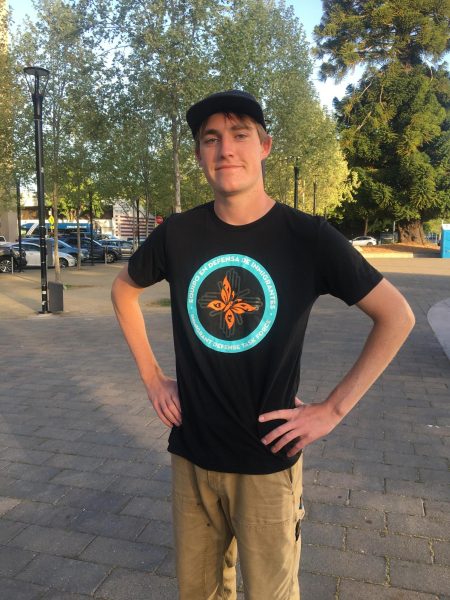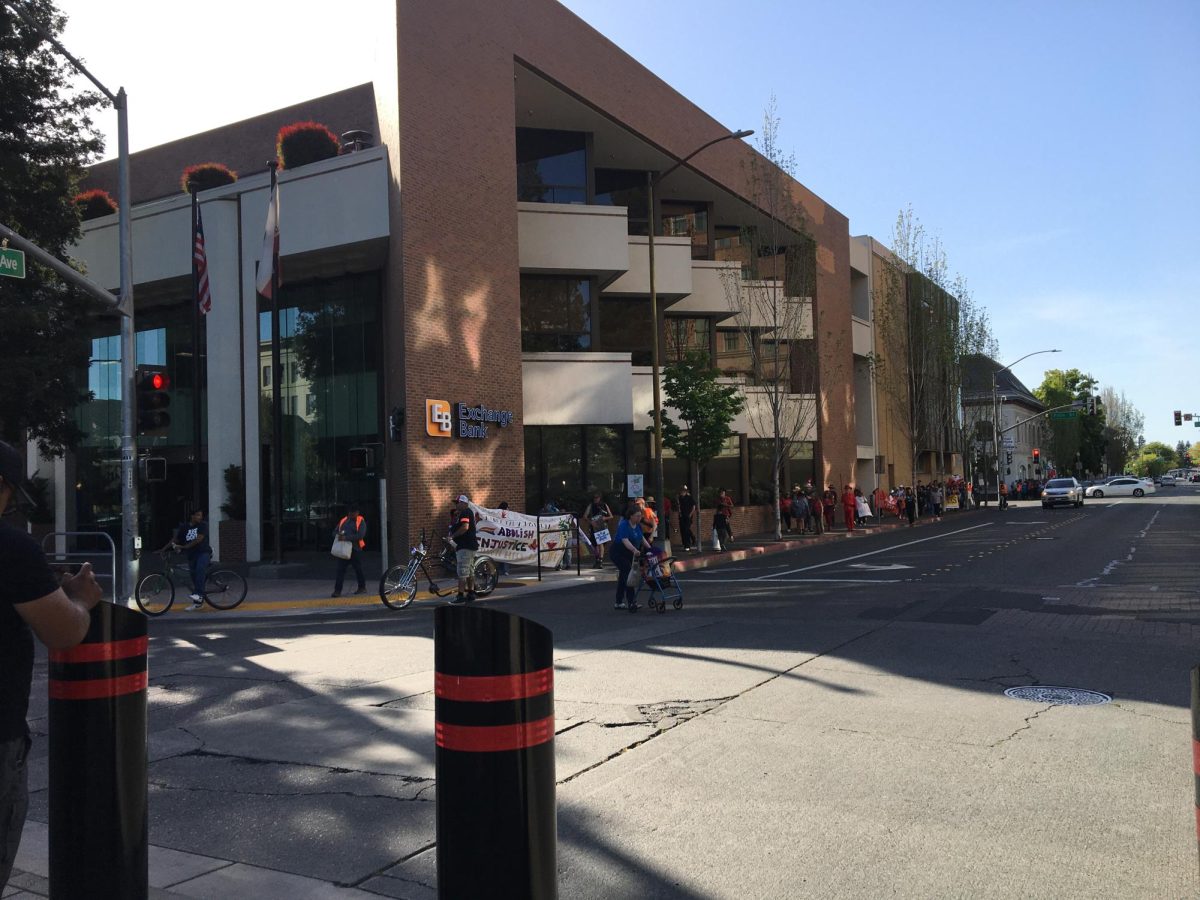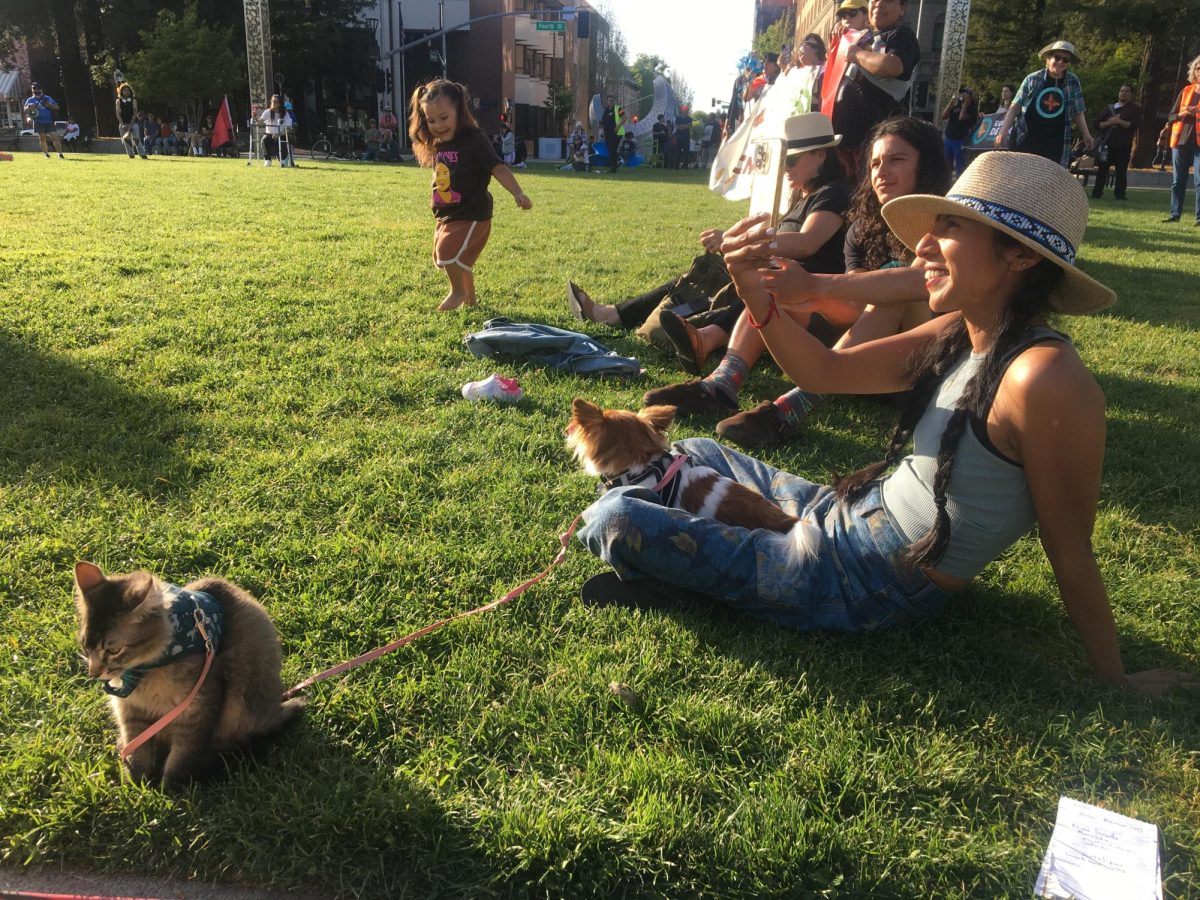Students representing Santa Rosa Junior College, Sonoma State University, local activists and community members, many from migrant communities, assembled at the Sonoma County Sheriff’s Office to march for immigrants’ and workers’ rights on International Workers’ Day May 1 in Santa Rosa.
The march began in front of the sheriff’s office where participants delivered a letter demanding immigration reform and a safe sanctuary ordinance for Sonoma County. From there, the march continued to the Board of Supervisors’ office to deliver a copy of the same letter and then onward to Courthouse Square for a rally.
Slightly before 3 p.m., about 100 attendees gathered in the county parking lot bearing signs proclaiming, “Si Se Puede” and “Update the Registry Bill.” A cotillion of orange-vested safety monitors received instructions as marchers arrived pulling wagons of food and water. Nanahuatzin Aztec dancers offered a blessing of the space before activists delivered the letters at both destinations, then led the marchers downtown.
At the head of the march, Laura Escutia, 19, of Santa Rosa carried the banner proclaiming “Abolish Injustice.” A Mexica dánzate, or indigenous dancer, Escutia has led many marches, which she has participated in since childhood. The SRJC student came out to amplify unheard voices and to support her community. “I come from immigrant parents that were able to get citizenship, but I know not many kids have that.” As a U.S. citizen, she feels she protests without fear of reprisals. “I’m lucky that I get to be out here and put that lucha [Spanish, for “fight’’] out here.”
Anna Salgado, of Santa Rosa, works as a senior caregiver. She marched for farm workers who “deserve a safe place to work,” and to be treated with dignity, she said. “They are the ones who provide our three meals on our tables.” Salgado described farm workers being required to work in heavy smoke from wildfires, which causes respiratory health problems. Farm workers deserve work protections, including language justice which would ensure that workplace safety information is available in the languages farm workers use in their daily lives, according to Salgado.
But workers do not feel safe speaking out about unsafe working conditions and sexual harassment. “My sister was dismissed from her job before her contract ended because she spoke at a May Day rally in 2022,” Salgado said.
Fear of retaliation, disillusionment, or the difficulty taking time off on a workday may explain the lower than expected turnout.
“People are disillusioned,” said Luis Bravo, co-organizer of the event. Bravo, a high school counselor in Napa, has organized this event since the first march in 2006.
That year, two separate bills, one from the U.S. Senate and the other from the House of Representatives, galvanized immigrant and migrant communities and allies. The Senate bill, S 2611, proposed increasing the number of guest workers, allowing some long-term undocumented immigrants to gain legal status and increasing border patrol. This bill passed in the Senate. The House bill, HR 4437, focused on border security and penalties for anyone involved in border-related immigration, including smugglers, employees and people providing humanitarian assistance to undocumented immigrants. The bill passed in the House.
Across the nation in 2006, millions rallied around the cause to protest H.R. 4437. In Sonoma County, the May First Coalition organized a march and rally, which would become an annual event. The first year an estimated 10,000 people marched for immigrants’ and workers’ rights in Santa Rosa.
Ultimately, neither bill passed. But the collective energy coalesced into strong community-based advocacy for immigrants and migrants.
Eighteen years later, people are still committed to the fight for immigration reform, Bravo said. But the lack of progress is taking its toll. “We know that to get immigration reform, we need 16 senate votes,” he said, unlikely in today’s political climate.
Immigration regulation goes on behind closed doors, Bravo said. “It doesn’t generate the same reaction in the community.”
This year, about 150 participants reached Courthouse Square where they held a rally with speakers who spoke about their personal experience with central issues impacting local immigrants and workers, including the registry bill, wage theft, police presence in schools, language justice, workers’ rights and the ceasefire in Palestine.
Despite smaller numbers, the march and rally brought new and seasoned marchers together.

Maria Hunt teaches Spanish, cooking and other cultural aspects of Latino culture at Sonoma Earth School. She came to support immigrant rights and the passage of the registry bill that would make it easier for undocumented immigrants who have lived and worked in the United States for many years to gain citizenship.
Jorge Aleman, 40, of Santa Rosa, sat in the grass on Courthouse Square with his wife and two children, and several members of his extended family. He has participated in May Day events here for 18 years, he said. He met his wife at SRJC, and they bonded over the fact that they both participated in May Day marches.
Jonah Knuth, senior at Sonoma Academy, participated in the march for the second time. He became involved a year ago in the non-profit Immigrant Defense Task Force after becoming concerned about over-policing in Santa Rosa and how, “The United States treats immigrants,” he said.
Knuth referred to a state-mandated report that the Sonoma Sheriff’s Office released in November 2023 as required by the 2016 Truth Act. The report showed that the Sheriff’s Office had notified federal agents of inmates’ release 64% more often in 2022 than in 2021.
The report showed that requests for those notices from U.S. Immigration and Customs Enforcement jumped 184% in 2022 from 2021.
According to the Sheriff’s Office, it only releases this information in situations involving serious, violent felonies.
However, the North Bay Organizing Project (NBOP), an immigrant advocacy group, disputes this. According to NBOP, the mandated report contains inaccuracies and a lack of transparency, namely, that the annual reports do not clarify what type of information gets sent to ICE. Specifically, the reports do not say why the people were arrested or what, if any, previous criminal record they had. This lack of transparency breeds distrust and creates fear among the immigrant and migrant population.
Many who did participate in Wednesday’s march and rally spoke about their deep ties to the local community. Several, like Aleman, have marched since 2018. Teresa Solis of Santa Rosa said she’s participated in May Day marches for 24 years.
On the other end of the spectrum is Avril, a 16-year old freshman at Roseland University Prep, who marched for the first time. Avril, who declined to provide her last name, found the event impactful and “fun representing my community.”





